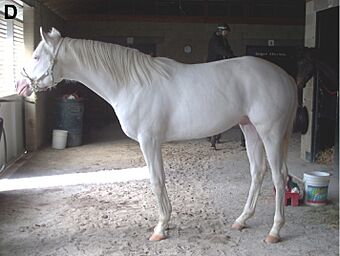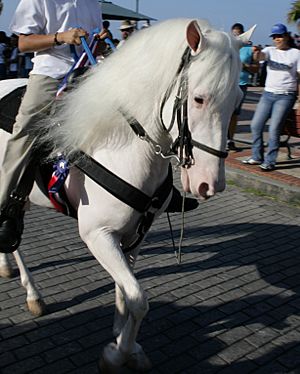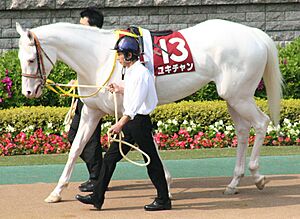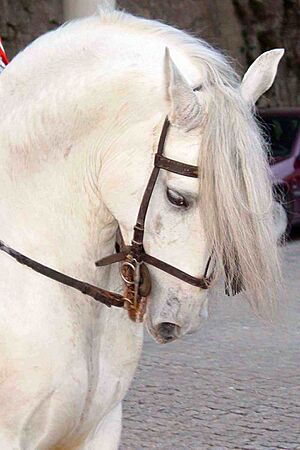White horse facts for kids
Quick facts for kids White horse |
|
|---|---|

Dominant purebred white stallion
|
|
| Genotype | |
| Base color | Dominant white |
| Skin | White |
A white horse is born mostly white and stays white its whole life. These horses usually have pink skin under their white hair. Their eyes can be brown, blue, or hazel. Truly white horses, especially those with special dominant white (W) genes, are quite rare.
Most horses people call "white" are actually gray horses. Gray horses can be born any color. Their hair gradually turns white as they get older. Almost all gray horses have dark skin, except for any white marks they were born with. The easiest way to tell a grown-up white horse from a gray horse is by looking at their skin color.
Contents
What Makes a Horse Truly White?
White horses have skin that doesn't have much color (unpigmented) and a white hair coat. Many have dark eyes, but some have blue eyes. Gray horses are born with colored skin that stays that way. Their hair starts colored and then turns white as they age. But true white horses are born with white hair and mostly pink, unpigmented skin.
Sometimes, white horses are born with a little color in their skin and hair. This color might stay or fade as they grow up. When a white horse lightens, both its skin and hair lose color. Gray horses, however, keep their skin color, and only their hair turns white.
White colors in horses, like white markings, white patterns, or dominant white, happen because parts of the skin don't have pigment cells. These cells are called melanocytes. Scientists are still learning a lot about the genes that cause different all-white looks.
Dominant White Genes
Dominant white (W) is a big group of alleles, which are different forms of a gene. These genes usually make horses with pink skin, all-white coats, and brown eyes. Some dominant white horses might have a little bit of color along their back. Some W genes can also cause white spots on horses that are mostly dark.
Scientists have studied dominant white in many breeds. These include Thoroughbreds, Arabian horses, and the Camarillo White Horse. As of 2021, there are 32 different types of dominant white genes. Each one comes from a horse that was born white and had a change (a mutation) in a gene called KIT.
Dominant white horses often have white noses. These noses can get sunburn easily, so they might need protection.
Sabino-White Horses
Sabino-white horses have pink skin and coats that are all white or almost all white. They usually have dark eyes. These horses have two copies of a specific gene called SB1. This gene is found in many breeds. These include Miniature horses, American Quarter Horses, and Mustangs.
The Sabino1 gene does not cause any health problems. However, sabino-white horses may need some protection from sunburn. Horses with only one copy of the Sabino1 gene often have dramatic white markings. These can include two or more white legs, a lot of white on the face, and white spots on their body.
White Born Leopard Horses
The leopard complex is a gene called Leopard (LP). It gives Appaloosa and Knabstrupper horses their spotted coats. This gene is very different from other genes that cause white or white-spotted patterns.
A pattern called "fewspot leopard" can look almost white. If a foal has two copies of the LP gene and a lot of white patterning, it will look almost white when born. These horses are sometimes called "white born." Horses with two copies of the LP gene have a higher chance of having night blindness. This means they can't see well in the dark.
Lethal White Syndrome
Lethal white syndrome is a serious genetic problem. It is linked to the Frame overo (O) gene. This condition is most studied in the American Paint Horse. Foals born with this syndrome look normal at birth. They have pink skin, all-white or nearly-white coats, and blue eyes.
However, a part of their gut called the colon does not work. This is because it is missing nerve cells. There is no treatment for this condition. Foals with Lethal White Syndrome always get severe colic and die within 72 hours. They are usually put to sleep to prevent suffering.
Horses that carry the gene are healthy and normal. A DNA test can find out if a horse is a carrier.
Horses That Look White But Aren't
Genetically white horses have unpigmented pink skin and white hair. Their eye color can vary. The lack of color in their skin and hair is because they don't have pigment-producing cells called melanocytes.
Some horse coat colors look light or white, and might even have pinkish skin. But these horses still have melanocytes. Their white-like coats happen because the melanocytes produce pigment in different ways.
Gray Horses
Gray horses are the most common "white-like" coat color. The biggest difference between a gray horse with a white coat and a true white horse is skin color. Most gray horses have black skin and dark eyes. White horses have light, unpigmented skin.
The gray gene does not change skin or eye color. So, grays usually have dark skin and eyes. Their skin and eyes might be other colors if they have white markings or other genes that lighten color. Gray foals can be born any color. But their colored hairs gradually turn white as they get older. This makes adult gray horses look white or almost white.
Gray horses have a higher risk of getting a type of skin cancer called melanoma. About 70-80% of gray horses over 15 years old have a melanoma tumor.
Diluted Coat Colors
True white hair grows from unpigmented skin that lacks melanocytes. In contrast, horses with diluted coat colors have melanocytes. But the color is lighter because of how much pigment these cells make. There are at least five types of pigment dilution in horses. Three of these can make horses look off-white.
Horses with very diluted coat colors often have pale eyes, usually blue. Their coats are cream-colored, and their skin is rosy-pink with very little pigment. White markings are usually still visible if you look closely.
- The Cream gene makes two types of diluted colors. Horses with fully diluted colors are called Cremellos, perlinos, and smoky creams. They have rosy-pink skin, pale blue eyes, and cream-colored coats that can look almost white. These colors happen when a horse has two copies of the cream gene. The cream gene does not cause any known health problems.
- Pearl-Cream pseudo-double dilute happens when a horse has one cream gene and one pearl gene. These two genes work together to make a cremello-like coat. Pearl-cream horses have pale but colored skin and blue-green eyes. Their coats are a distinct pale cream color.
- Champagne-Cream pseudo-double dilute happens when a horse has one cream gene and one champagne gene. Champagne and cream are another pair of genes that work together to make a cremello-like coat. Champagne-cream horses have freckled, pinkish skin, pale eyes, and pale coats. These colors used to be called "ivory champagnes." This gene is not known to cause any health problems.
Are White Horses Albino?
White horses are sometimes called "albino," but there are very few cases of a truly "albino" horse. Dominant white in horses is caused by missing pigment cells. But albino animals have a normal number of pigment cells. In other animals, patches of unpigmented skin, hair, or eyes due to missing pigment cells are called piebaldism, not albinism.
All so-called "albino" horses have colored eyes, usually brown or blue. True albino animals would have very pale blue or white eyes. Many albino mammals, like mice or rabbits, have white hair, unpigmented skin, and reddish eyes.
The definition of "albinism" can change depending on whether we are talking about humans, other mammals, or other animals. No gene changes related to albinism in other mammals have been found in horses. Horses do not have the same vision problems that are linked to albinism in humans. Blue eyes in horses do not mean they have poor vision.
Some horse registries still use the term "albino." For example, the Paso Fino Horse Association registers cremellos and other cream colors as "albino." The American Quarter Horse Association (AQHA) used to call perlino or cremello horses "albino" until 1999. They later changed the word to "cremello or perlino."
Famous White Horses
Many famous horses from the past and present were said to be "white" by people, but they were actually gray horses whose coats had turned completely white. Also, most white horses used in movies are actually grays. This is partly because they are easier to find.
However, a few truly white horses have been in movies. One well-known example was "Silver," ridden by the Lone Ranger. This role was played by two different white horses. At least one horse who played "Topper," ridden by Hopalong Cassidy, was also white.
Another famous white horse is Sodashi. She is a Japanese Thoroughbred racehorse who won important races.
White Horses in Stories and Myths
Throughout history, white horses have been important in many cultures' myths and stories. For example, the ancient Greek historian Herodotus wrote that white horses were considered sacred animals in the court of Xerxes the Great (who ruled from 486–465 BC). In many traditions, a white horse carries patron saints or a world savior at the end of time. This idea appears in Hinduism, Christianity, and Islam.
See also
 In Spanish: Caballo blanco para niños
In Spanish: Caballo blanco para niños





